DODGE DURANGO 2018 Owners Manual
Manufacturer: DODGE, Model Year: 2018, Model line: DURANGO, Model: DODGE DURANGO 2018Pages: 592, PDF Size: 6.57 MB
Page 231 of 592
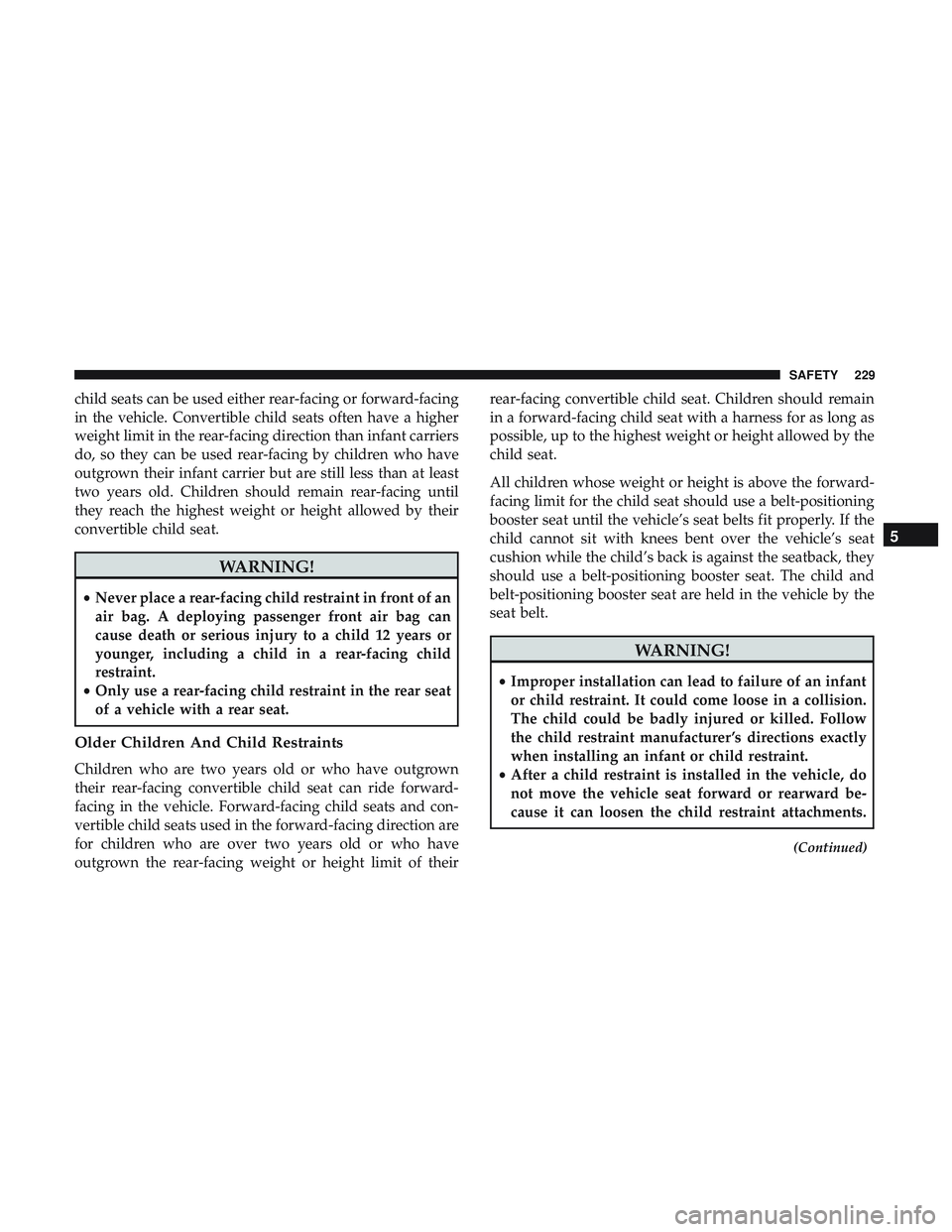
child seats can be used either rear-facing or forward-facing
in the vehicle. Convertible child seats often have a higher
weight limit in the rear-facing direction than infant carriers
do, so they can be used rear-facing by children who have
outgrown their infant carrier but are still less than at least
two years old. Children should remain rear-facing until
they reach the highest weight or height allowed by their
convertible child seat.
WARNING!
•Never place a rear-facing child restraint in front of an
air bag. A deploying passenger front air bag can
cause death or serious injury to a child 12 years or
younger, including a child in a rear-facing child
restraint.
• Only use a rear-facing child restraint in the rear seat
of a vehicle with a rear seat.
Older Children And Child Restraints
Children who are two years old or who have outgrown
their rear-facing convertible child seat can ride forward-
facing in the vehicle. Forward-facing child seats and con-
vertible child seats used in the forward-facing direction are
for children who are over two years old or who have
outgrown the rear-facing weight or height limit of their rear-facing convertible child seat. Children should remain
in a forward-facing child seat with a harness for as long as
possible, up to the highest weight or height allowed by the
child seat.
All children whose weight or height is above the forward-
facing limit for the child seat should use a belt-positioning
booster seat until the vehicle’s seat belts fit properly. If the
child cannot sit with knees bent over the vehicle’s seat
cushion while the child’s back is against the seatback, they
should use a belt-positioning booster seat. The child and
belt-positioning booster seat are held in the vehicle by the
seat belt.
WARNING!
•
Improper installation can lead to failure of an infant
or child restraint. It could come loose in a collision.
The child could be badly injured or killed. Follow
the child restraint manufacturer ’s directions exactly
when installing an infant or child restraint.
• After a child restraint is installed in the vehicle, do
not move the vehicle seat forward or rearward be-
cause it can loosen the child restraint attachments.
(Continued)
5
SAFETY 229
Page 232 of 592
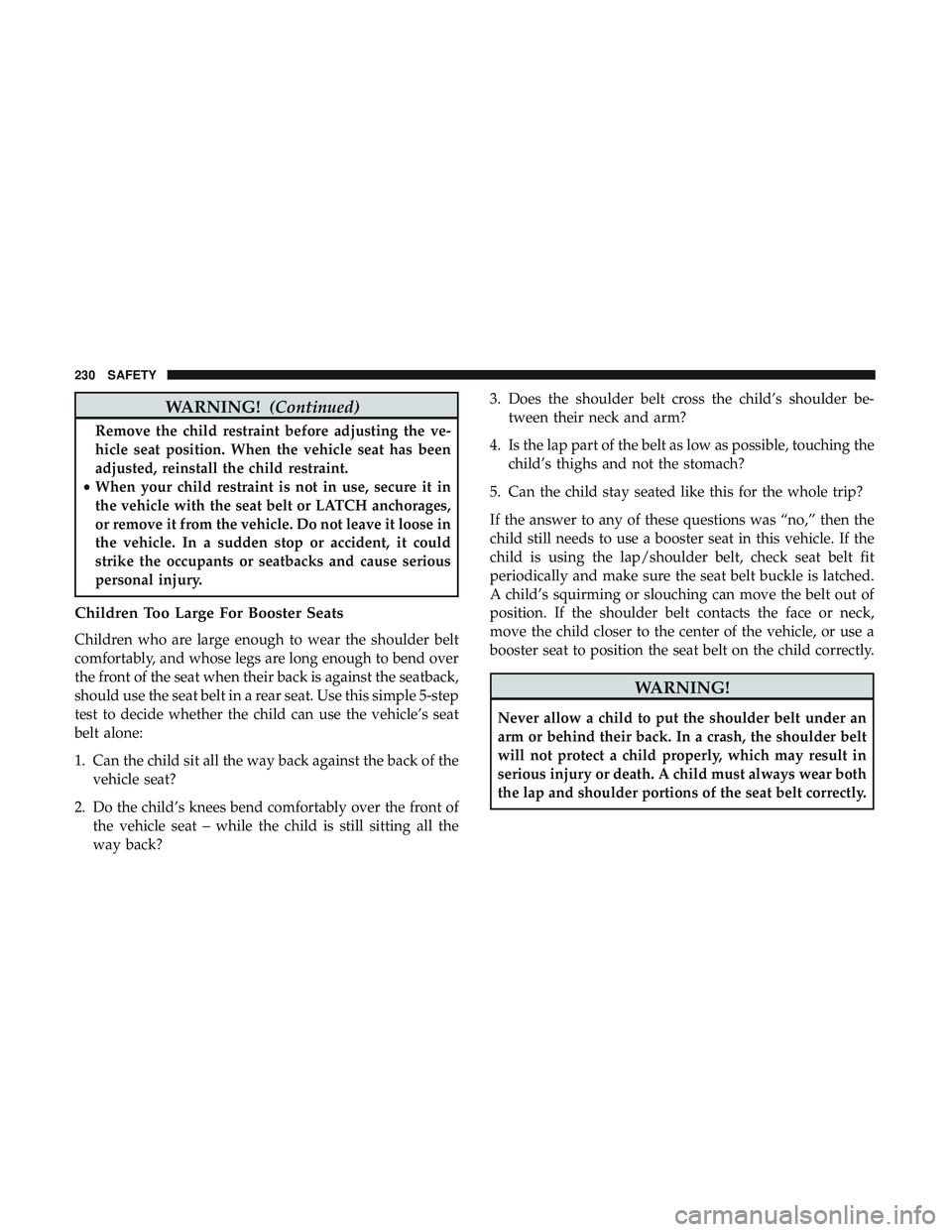
WARNING!(Continued)
Remove the child restraint before adjusting the ve-
hicle seat position. When the vehicle seat has been
adjusted, reinstall the child restraint.
• When your child restraint is not in use, secure it in
the vehicle with the seat belt or LATCH anchorages,
or remove it from the vehicle. Do not leave it loose in
the vehicle. In a sudden stop or accident, it could
strike the occupants or seatbacks and cause serious
personal injury.
Children Too Large For Booster Seats
Children who are large enough to wear the shoulder belt
comfortably, and whose legs are long enough to bend over
the front of the seat when their back is against the seatback,
should use the seat belt in a rear seat. Use this simple 5-step
test to decide whether the child can use the vehicle’s seat
belt alone:
1. Can the child sit all the way back against the back of the
vehicle seat?
2. Do the child’s knees bend comfortably over the front of the vehicle seat – while the child is still sitting all the
way back? 3. Does the shoulder belt cross the child’s shoulder be-
tween their neck and arm?
4. Is the lap part of the belt as low as possible, touching the child’s thighs and not the stomach?
5. Can the child stay seated like this for the whole trip?
If the answer to any of these questions was “no,” then the
child still needs to use a booster seat in this vehicle. If the
child is using the lap/shoulder belt, check seat belt fit
periodically and make sure the seat belt buckle is latched.
A child’s squirming or slouching can move the belt out of
position. If the shoulder belt contacts the face or neck,
move the child closer to the center of the vehicle, or use a
booster seat to position the seat belt on the child correctly.
WARNING!
Never allow a child to put the shoulder belt under an
arm or behind their back. In a crash, the shoulder belt
will not protect a child properly, which may result in
serious injury or death. A child must always wear both
the lap and shoulder portions of the seat belt correctly.
230 SAFETY
Page 233 of 592
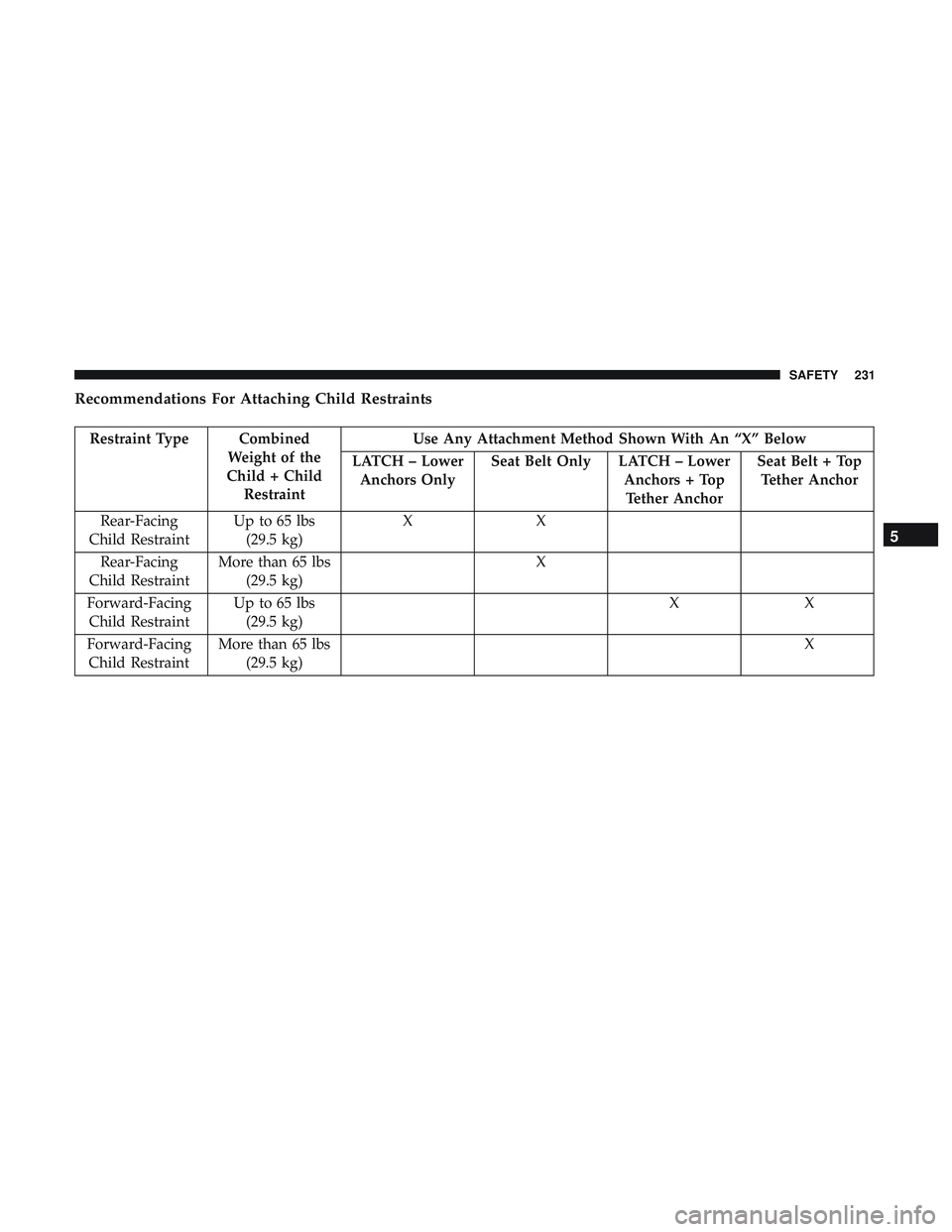
Recommendations For Attaching Child Restraints
Restraint Type CombinedWeight of the
Child + Child Restraint Use Any Attachment Method Shown With An “X” Below
LATCH – Lower Anchors Only Seat Belt Only LATCH – Lower
Anchors + TopTether Anchor Seat Belt + Top
Tether Anchor
Rear-Facing
Child Restraint Up to 65 lbs
(29.5 kg) XX
Rear-Facing
Child Restraint More than 65 lbs
(29.5 kg) X
Forward-Facing Child Restraint Up to 65 lbs
(29.5 kg) XX
Forward-Facing Child Restraint More than 65 lbs
(29.5 kg) X
5
SAFETY 231
Page 234 of 592

Lower Anchors And Tethers For CHildren (LATCH)
Restraint System
Your vehicle is equipped with the child restraint anchorage
system called LATCH, which stands for Lower Anchors
and Tethers for CHildren. The LATCH system has three
vehicle anchor points for installing LATCH-equipped child
seats. There are two lower anchorages located at the back
of the seat cushion where it meets the seatback and one top
tether anchorage located behind the seating position. These
anchorages are used to install LATCH-equipped child seats
without using the vehicle’s seat belts. Some seating posi-
tions may have a top tether anchorage but no lower
anchorages. In these seating positions, the seat belt must beused with the top tether anchorage to install the child
restraint. Please see the following table for more
information.
LATCH Positions For Installing Child Restraints In
This Vehicle
LATCH Label
60/40 Second Row LATCH Positions (5 Passenger)
Lower Anchorage Symbol (2 Anchorages Per Seating Position)Top Tether Anchorage Symbol
232 SAFETY
Page 235 of 592

60/40 Second Row LATCH Positions (7 Passenger)
Lower Anchorage Symbol (2 Anchorages Per Seating Position)Top Tether Anchorage Symbol
Captain’s Chairs Second Row LATCH Positions (6Passenger)
Lower Anchorage Symbol (2 Anchorages Per Seating Position)Top Tether Anchorage Symbol
5
SAFETY 233
Page 236 of 592

Frequently Asked Questions About Installing Child Restraints With LATCH
What is the weight limit (child’s weight + weight of the child re-
straint) for using the LATCH anchor- age system to attach thechild restraint? 65 lbs (29.5 kg)
Use the LATCH anchorage system until
the combined weight of the child and
the child restraint is 65 lbs (29.5 kg). Use the seat belt and tether anchor instead of the LATCH system once thecombined weight is more than 65 lbs (29.5 kg).
Can the LATCH anchorages and the
seat belt be used together to attach a rear-facing or forward-facing child restraint? No
Do not use the seat belt when you
use the LATCH anchorage system to
attach a rear-facing or forward-facing child restraint.
Booster seats may be attached to the
LATCH anchorages if allowed by the booster seat manufacturer. See your booster seat owner ’s manual for more information.
Can a child seat be installed in the center position using the innerLATCH lower anchorages? No – 5 Passenger
N/A — 6 Passenger No — 7 Passenger 7 and 5 Passenger: Use the seat belt
and tether anchor to install a childseat in the center seating position.
234 SAFETY
Page 237 of 592
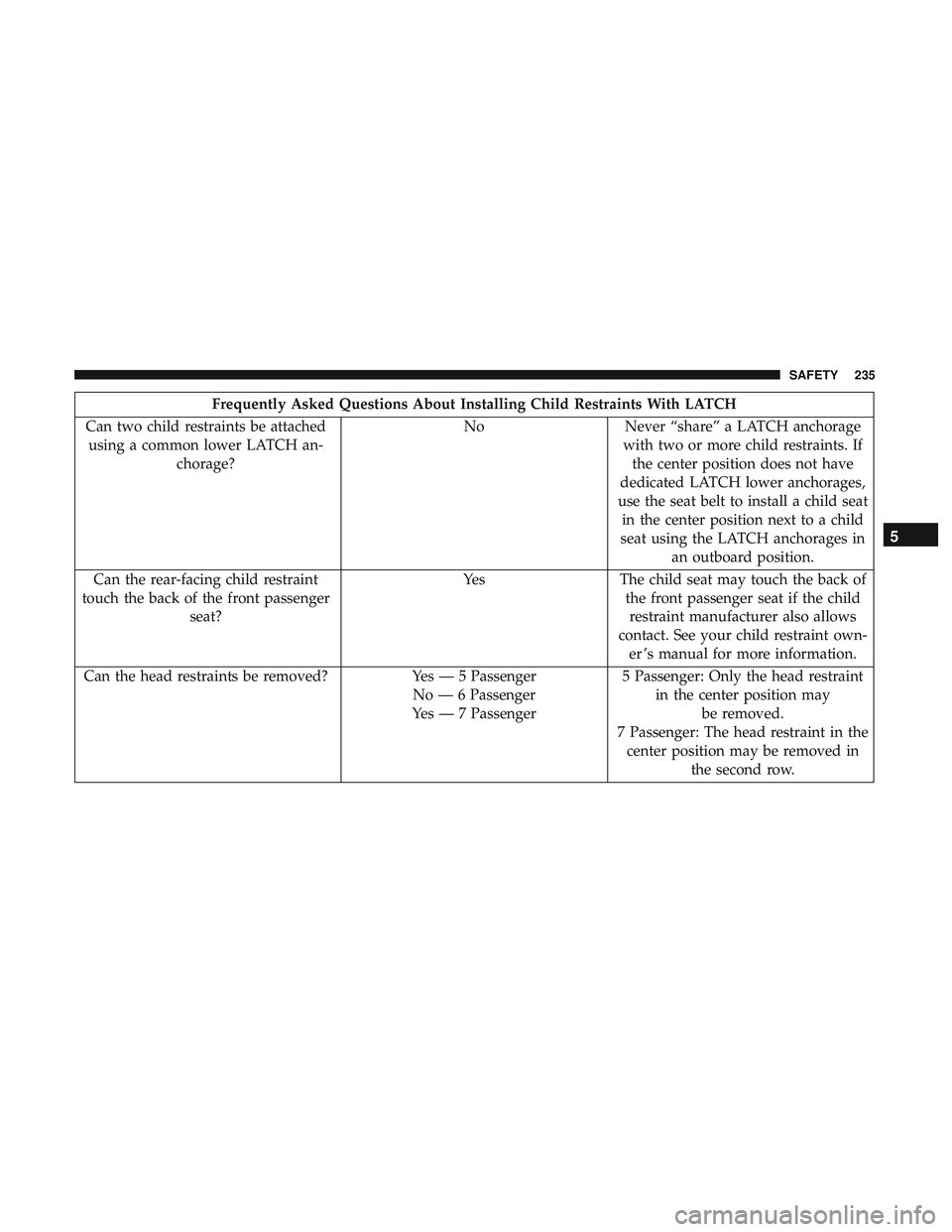
Frequently Asked Questions About Installing Child Restraints With LATCH
Can two child restraints be attached using a common lower LATCH an- chorage? No
Never “share” a LATCH anchorage
with two or more child restraints. If the center position does not have
dedicated LATCH lower anchorages,
use the seat belt to install a child seat in the center position next to a child
seat using the LATCH anchorages in an outboard position.
Can the rear-facing child restraint
touch the back of the front passenger seat? Yes
The child seat may touch the back of
the front passenger seat if the childrestraint manufacturer also allows
contact. See your child restraint own- er ’s manual for more information.
Can the head restraints be removed? Yes — 5 Passenger
No — 6 Passenger
Yes — 7 Passenger 5 Passenger: Only the head restraint
in the center position may be removed.
7 Passenger: The head restraint in the center position may be removed in the second row.
5
SAFETY 235
Page 238 of 592

Locating The LATCH Anchorages
The lower anchorages are round bars that are
found at the rear of the seat cushion where it
meets the seatback. They are just visible when
you lean into the rear seat to install the child
restraint. You will easily feel them if you run your finger
along the gap between the seatback and seat cushion.
Five Passenger Rear Seat Lower Anchorages
Six Passenger Rear Seat Lower Anchorages
236 SAFETY
Page 239 of 592
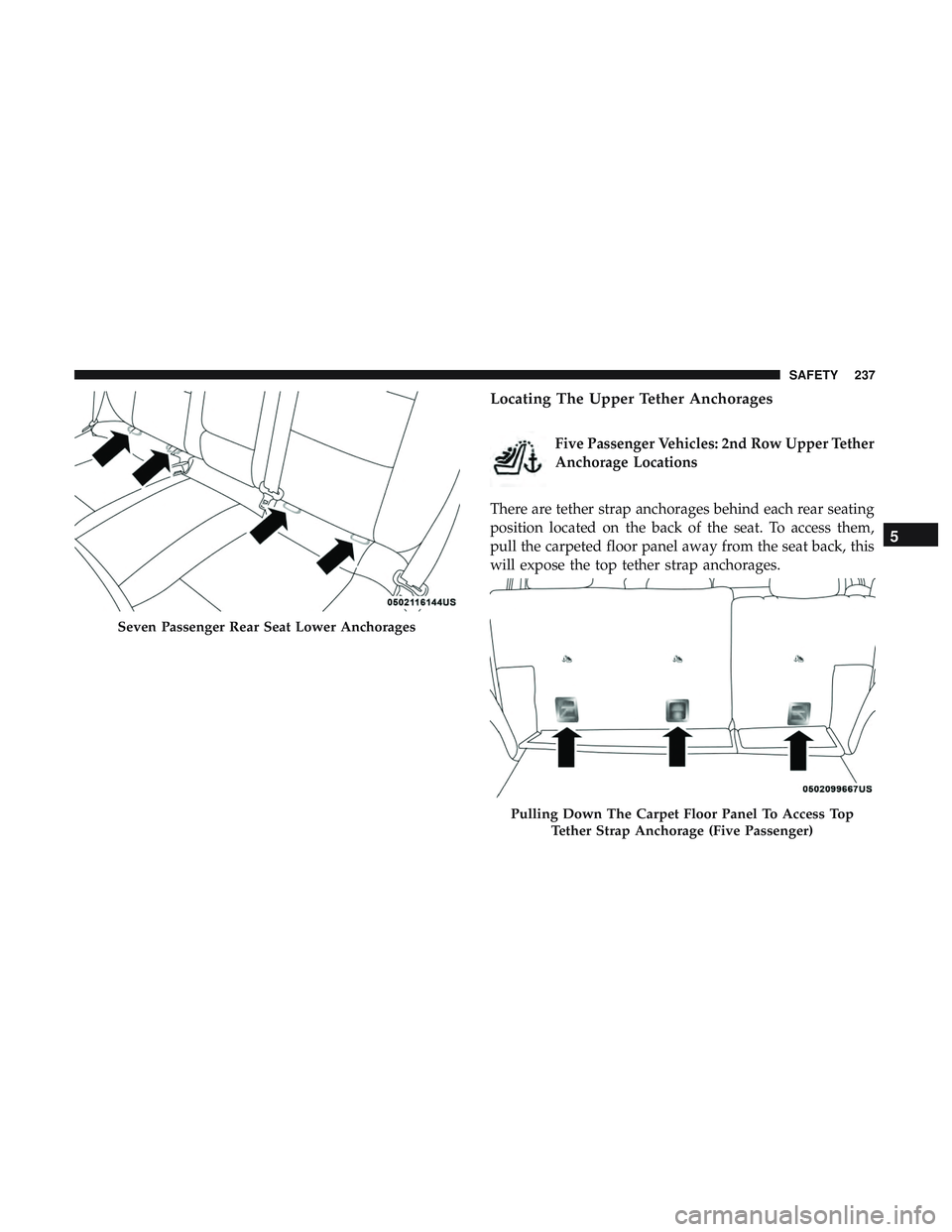
Locating The Upper Tether Anchorages
Five Passenger Vehicles: 2nd Row Upper Tether
Anchorage Locations
There are tether strap anchorages behind each rear seating
position located on the back of the seat. To access them,
pull the carpeted floor panel away from the seat back, this
will expose the top tether strap anchorages.
Seven Passenger Rear Seat Lower Anchorages
Pulling Down The Carpet Floor Panel To Access Top Tether Strap Anchorage (Five Passenger)
5
SAFETY 237
Page 240 of 592
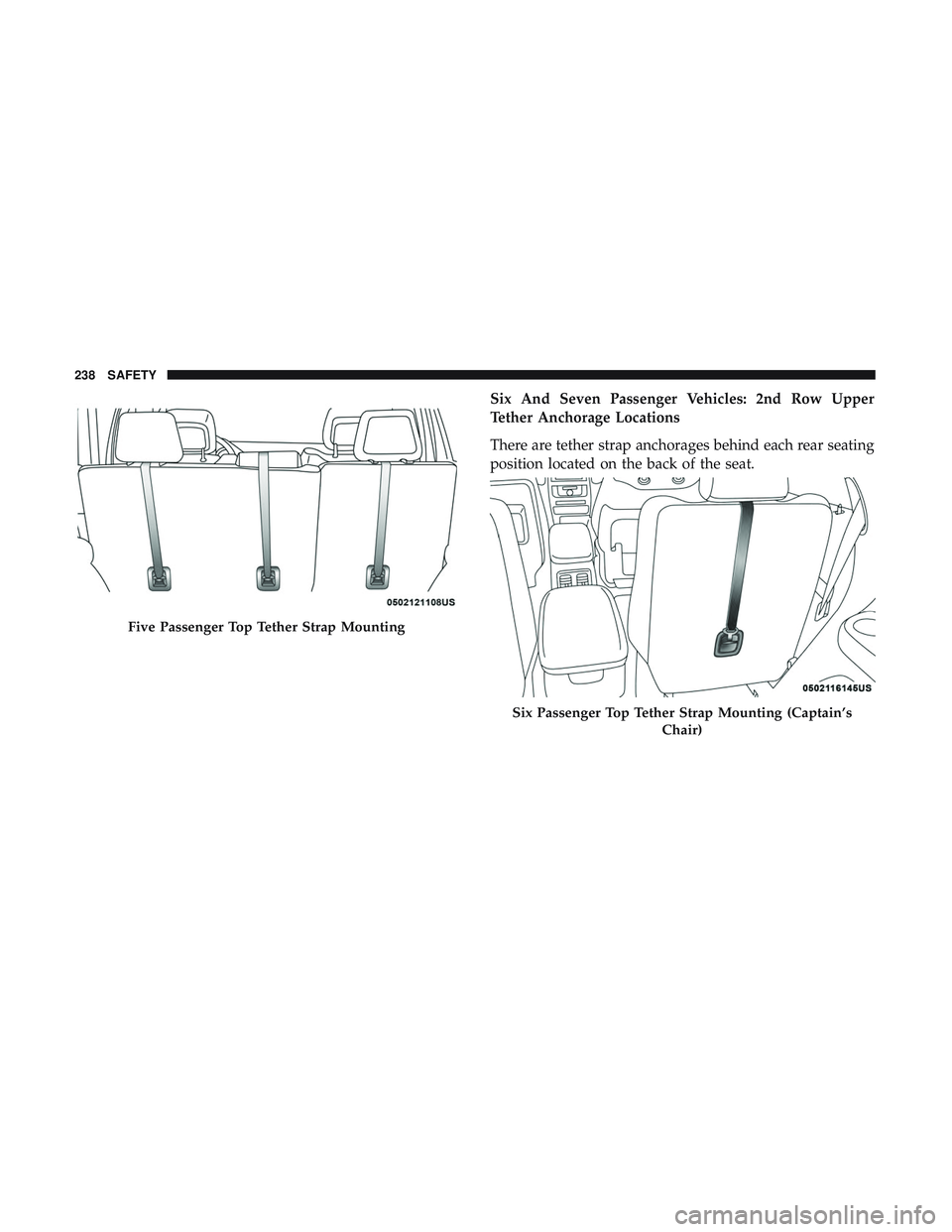
Six And Seven Passenger Vehicles: 2nd Row Upper
Tether Anchorage Locations
There are tether strap anchorages behind each rear seating
position located on the back of the seat.
Five Passenger Top Tether Strap Mounting
Six Passenger Top Tether Strap Mounting (Captain’sChair)
238 SAFETY